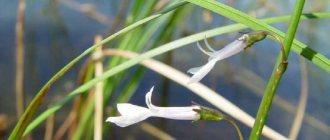Why am I struggling with moss in the garden?
Moss is a plant that is insidious in that it does not have roots or flowers, vessels or seeds. Prefers well-moistened, dark areas. Appears on the ground, stones, tree roots, walls, roofs of houses and greenhouses. Moss is not picky about environmental conditions and does not suffer from fungal and bacterial infections or insect pests. Capable of reproducing both vegetatively and by spores. A moisture-loving plant, however, it calmly tolerates prolonged drying out of the growing area.
Moss itself is a harmless green thing. However, only in a decorative sense, to decorate the landscape. The proximity of moss in beds with cultivated plants leads to inhibition of development and death of the latter:
- Mosses grow quite quickly over the soil surface. Such a dense “carpet” prevents the access of oxygen to the roots of cultivated plantings, inhibits the development of root systems, and suppresses beneficial soil bacteria.
- Moss is a moisture-loving plant with amazing absorbent abilities. It is capable of absorbing moisture in a volume 10 times greater than its own weight. This “superpower” is especially dangerous for neighboring cultivated plants during the dry period. In wet weather, it does not “give up” for a long time; it accumulates moisture around itself, making the surroundings swampy.
- It actively sucks moisture and nutrients from the substrate. By doing this, it takes away nutrition and water from cultivated plants and depletes the soil.
- Moss compacts the soil and impairs the drainage system.
- The weed promotes acidification of the substrate, which also inhibits the development of cultivated plants and reduces their immunity.
- The plant prevents the evaporation of excess moisture from the soil, and this is the reason for the emergence of a favorable environment for the spread of fungal diseases.
- They thrive in dense moss thickets, and small garden pests actively reproduce.
The most harmful moss for the garden is liver moss, the so-called marchantia. It can be easily confused with a lichen - it has “roots” that resemble a thin cobweb. If even a tiny piece of marchantia ends up in a greenhouse, it will quickly “conquer” the closed soil, depriving the roots of greenhouse plantings of access to oxygen. Be careful: marshanica spores often travel on Polish and Dutch seeds and bulbs.
Method 1. Soil deoxidation
It is necessary to determine the pH and nutrient content of the soil. If this is not possible, then there is no doubt that the mere presence of moss is an indicator of high soil acidity. It is desirable that the lawn grass competing with moss tolerates an alkaline environment well. A healthy lawn will require liming the soil and feeding it with organic fertilizer, compost, manure or other organic matter. Lime must be applied 2 times during the growing season.
- How to deoxidize the soil on the site - useful tips for gardeners and gardeners
Acidic soil on a site can destroy many plants and negate all efforts to grow them. How to correct soil acidity in beds and gardens?
Why is the ground covered with moss in the garden?
Its appearance on the site is a sure sign of its shading, high humidity, excessive density and acidification of the soil. Therefore, such a guest is a sure sign that you need to improve the structure of the substrate.
The appearance of moss in your garden or summer cottage is provoked by the following factors:
- Systemic darkening of certain areas.
- Waterlogging, waterlogging of the soil, stagnation of water in lowlands.
- Both excessive and insufficient application of certain fertilizers: deficiency of nitrogen and iron, supersaturation of phosphorus.
- Increased acidity of the substrate (best neutral pH, slightly acidic environment).
- Clay soil poor in organic matter.
- The grass on the lawns is cut too low.
- Compacted, not loosened soil.
- Fertilize the site with organic fertilizers that contain moss spores.
Depending on the influencing factor, the moss will also vary:
- On a lawn that is cut too short and the necessary fertilizers are not applied sufficiently, the plant spreads out in a continuous “mat.”
- On acidified or dried soil, moss grows in straight and long shoots, brown at the base and green towards the top.
- In areas that are too moist, swampy, shaded, or poorly drained, you will see moss with tops creeping along the ground.
- Periodic stagnation of water in an area is determined by moss peeking out from crevices and cracks on the ground.
Most often you can find it in a strawberry bed - this is due to both acidity and high humidity. I remove the weed before it covers the entire surface of the ridge with a continuous carpet. At the same time, dried peat sphagnum moss, on the contrary, is useful for strawberries as mulch: it improves the structure of the soil, maintains the necessary moisture content of the substrate, and forms an optimal pH for the crop.
Make grooves
Waterlogged soil is a favorable environment for the growth of moss. The degree of soil moisture is determined visually, by how a lump of earth taken from the surface crumbles. If stagnant water is detected, the area should be dried.
A system of drainage grooves is installed on the territory to remove moisture. A good solution would be to dig deep trenches around the perimeter of the site. The walls of such ditches are reinforced with durable material, such as slate, to prevent the soil from falling off and being washed away.
MOST READ FROM PARTNERS
How to remove moss from the soil in the garden
We have determined that moss is not the most welcome guest in the garden plot. Therefore, below are effective methods of getting rid of it, tested from our own experience.
Soil deoxidation
The moss on the site itself is already an indicator of acidification. However, before taking active steps, I still recommend that you determine the pH of the substrate using precise methods. You can use litmus tests, which are available in garden centers today.
litmus paper
If your fears are confirmed, then you need to act according to the algorithm:
- Deoxidize the soil. Use good old fashioned liming here.
- Periodically apply mineral and organic fertilizers - compost, manure.
- Plant plants that are resistant to alkaline conditions.
The simplest deoxidation method is liming. 100-200 g of substance is required per 1 m2. The best time for the procedure is autumn, after harvesting, before digging.
Reducing humidity
Reducing the soil moisture in an area affected by moss is another way to get rid of this plant. Most likely, the problem arose in an area with poor drainage and too heavy a clay substrate. The water stagnates and slowly drains away.
Every year I dig and update grooves to drain melt and rain water. An effective way is to organize a drainage system:
- Along the perimeter of the garden I dig grooves with a depth of 50 cm.
- I lay drainage pipes, pre-wrapped with geotextile, at the bottom of the recesses.
- I lead the pipes to a barrel dug into the ground.
- I’m already draining the barrel to drain excess water into the ditch.
- I bury it with a mixture of gravel and earth.
Another solution is to soften, loosen, and improve the structure of the soil. For these purposes, I periodically add river sand and humus. As a preventative measure, I promptly remove plant debris and straw.
An effective measure throughout the season is adjusting watering schedules. Excessive water procedures and watering at dusk are the cause of the appearance of moss. You need to be especially careful with watering in spring and autumn - the moss that appears during these seasons will be the most indestructible.
Weed control
Remove weeds from your garden beds periodically. Under their shade, optimal conditions are created for the life and spread of moss.
It would also be a good idea to loosen areas with a dense earthen crust covered with moss. I use a fine-tooth rake in the garden beds and lawnmower blades on the lawn.
Fertilizing
To prevent the area from being occupied by moss, focus on applying fertilizers with a high content:
- nitrogen;
- gland;
- potassium
The most effective for this problem are ammonium nitrate and nitroammophoska. It is equally important to annually apply organic fertilizers in sufficient quantities - humus, pine needles or compost. Their worthy alternative is green manure. This will kill “two birds with one stone”: saturate the soil with nitrogen, plant the area with a dense “carpet” of green manure that prevents the spread of moss.
fertilizer for the garden
Mulching
Another simple and useful way to remove moss is to mulch the area with natural, natural compounds. I use sawdust and straw mulch. Pine needles and tree bark have also proven themselves well.
Fighting shading in the garden
As a rule, moss prefers shaded areas. To get rid of its presence in these areas, you can:
- Lighten the area. Remove unnecessary branches of a spreading tree, trim dense bushes.
- Plant the area with shade-loving crops. For example, hydrangea, fern, hellebore, etc.
Manual removal
As for the physical, manual removal of moss, this is a simple task: it has superficial small “roots”. Therefore, you can get rid of the unwanted neighbor by simply loosening it with a rake. There is also a less force-intensive method: cover the area affected by moss with non-woven black material. Do not remove the film until the weed is completely dead. Then remove and burn to prevent its spores from spreading.
If you observe the dominance of moss in the area, take other measures:
- Cut it off along with the top layer of soil.
- Lime the area: cover the surface of the soil with quicklime, and after a day, water the soil with water to slak it.
- Treat the area with a motorized cultivator. If the area is small, manual digging is also suitable.
- If desired, the removed top layer of soil saturated with harmful spores can be replaced with fresh, uninfected one.
- Cover the area with a good layer of natural mulch - sawdust, bark, pine needles, straw, etc.
Chemical countermeasures
If paths, lawns, areas not sown with cultivated plants are overgrown with moss, you can apply a chemical composition to save time:
- A solution of glyphosate-containing herbicides.
- Iron sulfate solution: 90 ml of the substance - per 20 liters of water.
- Copper sulfate solution: 50-150 ml - per 16 liters of water.
- A solution of iron or copper sulfate with a concentration of 5%. For 1 hectare of land, 2 liters of composition are required.
- Soap solution, baking soda, kitchen dishwashing detergent: 200 g (200 ml) per 2 liters of heated water. Please note that such a harmless solution can only provide a temporary effect.
- English remedy: for 4 liters of water - 1 tbsp. spoon of baking soda, ¼ teaspoon. spoons of castile soap, 2 tbsp. spoons of vegetable oil.
Cover with sand
MOST READ FROM PARTNERS
To reduce soil moisture, small holes 15-20 cm deep are made in places where moss accumulates. They are filled with coarse-grained river sand. The same procedure is carried out after mechanical removal of the parasitic plant so that the remaining spores and roots cannot germinate on the cleaned soil.
Although holes with sand do not always look aesthetically pleasing, after a while the bald spots will be overgrown with grass, which will not allow the bryophyte to reappear.
Moss in a greenhouse: how to get rid of it
Judging from my own experience, I will say that the most difficult thing to get rid of moss is in a greenhouse. The following measures were effective:
- Liming greenhouse soil in the fall (for digging), adding dolomite flour in the spring.
- Combating waterlogging, waterlogging, improving the structure of the substrate by backfilling coarse-grained river sand.
- Arrangement of high and well-drained ridges.
- Systematic procedures for soil aeration are simply loosening.
Reduce shading
The lack of sunlight also promotes the reproduction and growth of moss. To combat bryophyte, they try to remove excessive shading wherever possible. Thin out dense, spreading crowns of trees, remove unnecessary objects and debris.
If a shadow falls from a house or outbuildings, the sun's rays are reflected using mirror surfaces - a sheet of metal or foil. In areas where it is not possible to increase illumination, shade-loving plants are planted. As they grow, they will crowd out the moss.
Preventive measures
I’ll tell you about general preventive measures designed to prevent formation on your site:
- Systematic leveling of highlands and lowlands, which does not allow excess moisture to accumulate in the latter.
- Mulching beds with natural materials.
- Timely fertilizing of plantings with nitrogen and iron-containing fertilizers.
- Preventing constant shading of large areas on the site.
- Systematic aeration of the soil in the beds - treatment with pitchforks and rakes after rainfalls and waterings.
- Compliance with the schedule of water procedures, avoiding excessive watering.
- Creating a high-quality drainage system - this point is especially important in relation to greenhouses and greenhouses.
- Growing peas, mustard or cress in a continuous “carpet” is an effective remedy against the insidious Marchantia.
If you notice it on the roof of a greenhouse or garden house, you can remove it using powder, granular, or liquid herbicides. Most often, copper, iron, ammonium sulfate, and glyphosate-based preparations are used. On average, 40-50 ml of product is required for 5 liters of water. This is sufficient volume to treat an area of 150 m2.
If in the spring you see moss on garden paths, also turn to a chemical method of resistance. Lintur, Roundup, ETISSO are good for tiled paths. These remedies help against both mosses and lichens.
Moss is a generally harmless plant. However, due to its vitality and unpretentiousness, it is an extremely undesirable neighbor for cultivated plants - it takes away their nutrition and moisture, and deprives the roots of plantings of access to air. Moss can be effectively combated in beds, in a greenhouse, on paths, walls and roofs - mechanical, chemical, manual and other methods.
Use herbicides
They fight moss in their summer cottage using radical methods - with the help of chemicals. General herbicides destroy moss growths, spores, roots and shoots.
The affected areas are treated in calm, sunny weather with a sprayer, using a protective mask and gloves. After 2-3 days, spill with water. After the bryophyte turns black, it is removed with a rake, and the free space is sown with grass.
Herbicides should be used with caution - together with moss, they can destroy part of the lawn or crops.
Preventing the appearance of moss
Having gotten rid of the moss once, you need to do everything to prevent it from growing again. There are many ways to do this:
- Leveling the lawn.
After the moss has been removed, care should be taken to eliminate the reasons that caused its appearance. First, the lawn must be leveled by soiling or mulching to prevent water from accumulating. - Adding new grass.
It needs to be sown in empty areas left after the destruction of moss. You can sow bluegrass, bentgrass or fescue. - Feeding.
It is necessary if the lawn grass is weakened. Fertilizers must contain nitrogen. It is better to carry out the procedure in winter, when there is still snow on the grass. There are also special fertilizers for lawn grass that contain iron sulfate and nitrogen. They are created not only for feeding, but also for fighting moss. - Increased sun exposure.
This is also one of the methods of dealing with dark areas. Therefore, it is necessary to try to clear the territory of the personal plot. Other plants and bushes should not be planted too densely, firewood or bricks should be moved to another location, and new buildings should not be built next to the lawn. - Aeration.
If your lawn is not properly maintained, over time the grass will grow so densely that it blocks the flow of air and moisture. Moss is guaranteed to appear in such an area. To prevent this, it is necessary to carry out aeration. It can be done using a special machine that digs out small areas of soil. This can be done manually, for example using a fork or rake. Aeration helps break down crusts on the ground and provide the soil with essential nutrients. The procedure should be carried out before or after the growing season. - Control of grass watering.
Excessive moisture leads to the appearance and rapid spread of moss. Experienced gardeners do not recommend watering the lawn at night, or in early spring and autumn. At this time, moss grows especially quickly. If the soil itself is too wet, it is necessary to dry it using aeration or a special drainage system. But it is necessary to water the grass, otherwise it will weaken and die. - Preventing damage to lawn grass.
Any excessive stress on your lawn will quickly weaken the grass. Therefore, you should not allow damage to the lawn due to games, cycling, etc. It is also important to ensure that insects do not harm it. Most often, the grass suffers from an invasion of long-legged mosquitoes. You need to fight them, otherwise you won’t be able to create a beautiful lawn.
Fighting moss requires constant attention and some effort. If the cause of the lawn infestation with moss has been correctly identified, using these methods you can achieve complete destruction of the parasitic plant. This takes approximately several weeks. As soon as it turns black and dries, it should be carefully raked and new grass sown in these areas. After this, all that remains is to apply preventive measures and then moss will not grow on it.
Method 7. Replacing lawn crops
Moss can grow in bare areas of the lawn where grass does not grow well. If there are such areas, it means that the grass chosen for the lawn is not resistant to shady conditions. The solution to the problem may be to replace the growing vegetation. Healthy grass will crowd out weeds and moss.
In an area cleared of moss, it is better to sow a mixture of lawn grass seeds containing ryegrass, fescue and bluegrass.
- Lawn grasses - what they are and what to choose
Have you decided to get a classic lawn, but don’t know what to sow for a quick and lasting effect? Our article is for you!
We hope you can find your option and this season enjoy a perfectly smooth and lush lawn without any excess vegetation.
Types of mosses
An effective remedy against moss is to establish its cause. With the right approach and choice of methods to combat moss, you are not only guaranteed to get rid of it, but also virtually eliminate the likelihood of its further appearance on your lawn. There are three main types of mosses:
- Upright moss has a green upper part and brown closer to the roots. Cause: dry and acidic soil.
- Creeping moss Green and yellowish shoots that spread in a dense carpet on the lawn. Reason: high humidity and lack of sunlight.
- Cushion moss Looks like a cushion of dense green shoots. Reason: low grass cutting.











